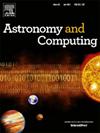Africanus III. pfb-imaging–A flexible radio interferometric imaging suite
IF 1.8
4区 物理与天体物理
Q2 ASTRONOMY & ASTROPHYSICS
引用次数: 0
Abstract
The popularity of the CLEAN algorithm in radio interferometric imaging stems from its maturity, speed, and robustness. While many alternatives have been proposed in the literature, none have achieved mainstream adoption by astronomers working with data from interferometric arrays operating in the big data regime. This lack of adoption is largely due to increased computational complexity, absence of mature implementations, and the need for astronomers to tune obscure algorithmic parameters. This work introduces pfb-imaging: a flexible library that implements the scaffolding required to develop and accelerate general radio interferometric imaging algorithms. We demonstrate how the framework can be used to implement a sparsity-based image reconstruction technique known as (unconstrained) SARA in a way that scales with image size rather than data volume and features interpretable algorithmic parameters. The implementation is validated on terabyte-sized data from the MeerKAT telescope, using both a single compute node and Amazon Web Services computing instances.
非洲III。pfb成像-一个灵活的无线电干涉成像套件
CLEAN算法在射电干涉成像中的流行源于其成熟、快速和鲁棒性。虽然文献中提出了许多替代方案,但没有一种方案被处理大数据体制下干涉测量阵列数据的天文学家所主流采用。这种缺乏采用主要是由于计算复杂性的增加,缺乏成熟的实现,以及天文学家需要调整模糊的算法参数。这项工作介绍了pfb成像:一个灵活的库,实现了开发和加速一般无线电干涉成像算法所需的脚手架。我们演示了如何使用该框架来实现一种基于稀疏的图像重建技术,即(无约束)SARA,该技术可以根据图像大小而不是数据量进行缩放,并具有可解释的算法参数。使用单个计算节点和Amazon Web Services计算实例,对来自MeerKAT望远镜的tb级数据进行了验证。
本文章由计算机程序翻译,如有差异,请以英文原文为准。
求助全文
约1分钟内获得全文
求助全文
来源期刊

Astronomy and Computing
ASTRONOMY & ASTROPHYSICSCOMPUTER SCIENCE,-COMPUTER SCIENCE, INTERDISCIPLINARY APPLICATIONS
CiteScore
4.10
自引率
8.00%
发文量
67
期刊介绍:
Astronomy and Computing is a peer-reviewed journal that focuses on the broad area between astronomy, computer science and information technology. The journal aims to publish the work of scientists and (software) engineers in all aspects of astronomical computing, including the collection, analysis, reduction, visualisation, preservation and dissemination of data, and the development of astronomical software and simulations. The journal covers applications for academic computer science techniques to astronomy, as well as novel applications of information technologies within astronomy.
 求助内容:
求助内容: 应助结果提醒方式:
应助结果提醒方式:


